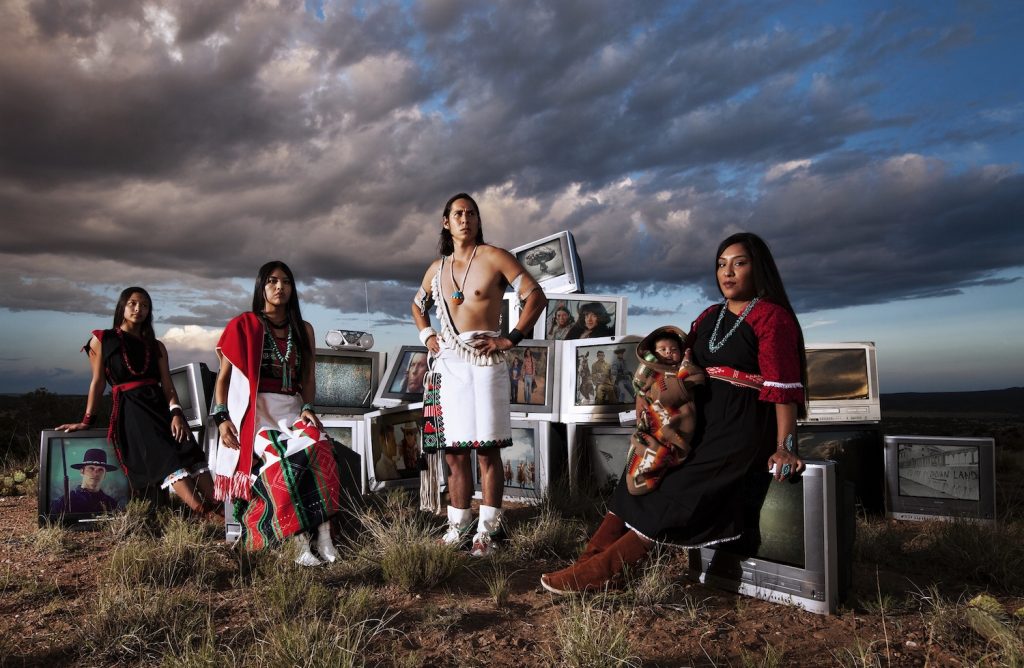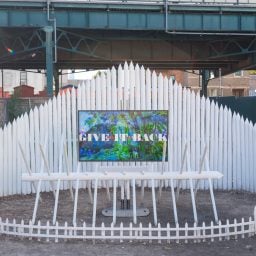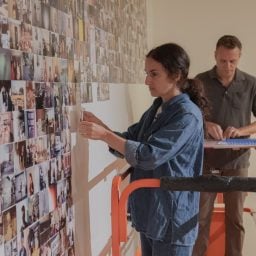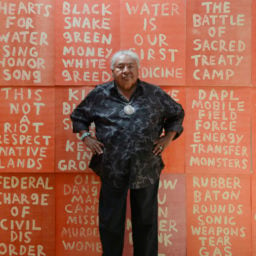Most of the pieces on view in the Minneapolis Institute of Art’s (MIA) new “In Our Hands” survey of Native photography from 1890 to now were lent directly by the artists who made them. That’s rare for museum shows like this one, which tend to rely on loans from public and private collections. Here, the condition speaks to a truth that goes beyond MIA: few institutions, if any, have a substantial collection of this kind of work.
“In Our Hands” is not the first exhibition of Native photography, of course. Even if the show could somehow lay claim to such a title, it wouldn’t, explained Jaida Grey Eagle, an Oglala Lakota photographer who guest-organized the presentation alongside MIA’s in-house curators Ahlberg Yohe and Casey Riley.
“I don’t look at this as a beginning,” Grey Eagle said, alluding to the colonialist logic of racing to be the first to put a name on something. “I look at it as an acknowledgment. There have been many people who have dedicated their lives to this medium and I don’t ever want to erase their work.” The show, she went on, is about “honoring the knowledge that has been there and that museums have failed to support.”
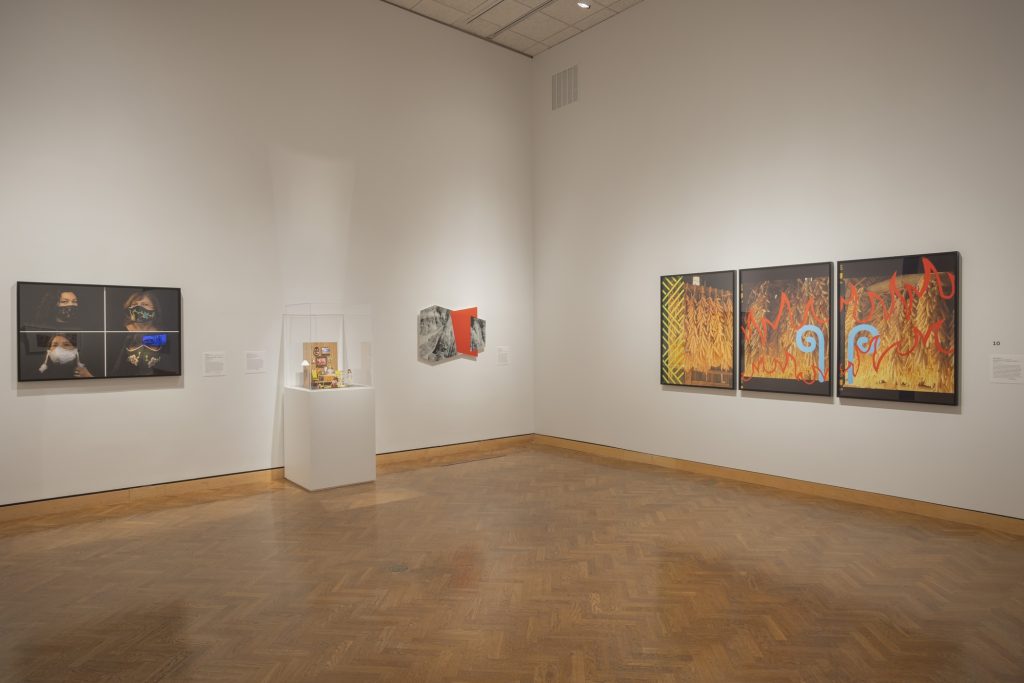
View of the exhibition “In Our Hands: Native Photography, 1890 to Now” at the Minneapolis Institute of Art, October 22, 2023 – January 14, 2024. Courtesy of MIA.
If the exhibition’s lack of loans speaks to a broader issue, it also underlines one of its central themes: community. Early one, Ahlberg Yohe, Grey Eagle, and Riley assembled a Curatorial Council of 14 artists and academics, most of Native heritage, who developed the list of participating artists and weighed in on the language used to describe their work.
The group also shaped the show’s three sections, each conceived with an emphasis on the present tense, regardless of the historical work included. “A World of Relations” looks at Native cultures’ holistic—not anthropocentric—view of living things; “Always Leaders” recognizes longstanding indigenous efforts around issues such as human rights, sustainability, and land preservation; and “Always Present” celebrates Native photographers who have used their medium to convey the vitality of their cultures.
“’In Our Hands’ was structured through conversations with Indigenous artists and scholars from its inception, so there never were ‘outside’ voices. This was a project that grew organically from our conversations with the folks who became our Curatorial Council,” Riley explained in an email.
“Our reasons for this were simple: we knew that centering their voices would be paramount in correcting historical narratives that erased Native people’s expertise. This project is built upon the work of people who came before us, who have been doing this work for a long time and should be the focus of scholarship from here on.”

Nadya Kwandibens, Tee Lyn Duke (née Copenace) Toronto, ON, March (2010). Courtesy of the artist and Red Works Photography.
Advisory committees like this have become increasingly common in recent years as museum workers grapple with the question of how to communicate cultural experiences beyond their own. That same question is what first drew Grey Eagle to photography as a reservation kid in South Dakota; it’s what pushed her to help develop the MIA show too.
“Growing up, I experienced a lot of journalists coming in,” she said, referring to her home community in South Dakota. “These were journalists flying across oceans to tell our story. As I got older, I started to notice that the articles that were coming out about my home community failed to encompass the entire story. They were always coming in to talk about strife. They never seemed to talk about why.”
To introduce readers to “In Our Hands,” Grey Eagle picked out several representative works to highlight.
Benjamin Alfred Haldane, Self-portrait in Studio in Metlakatla (c. 1919–20)
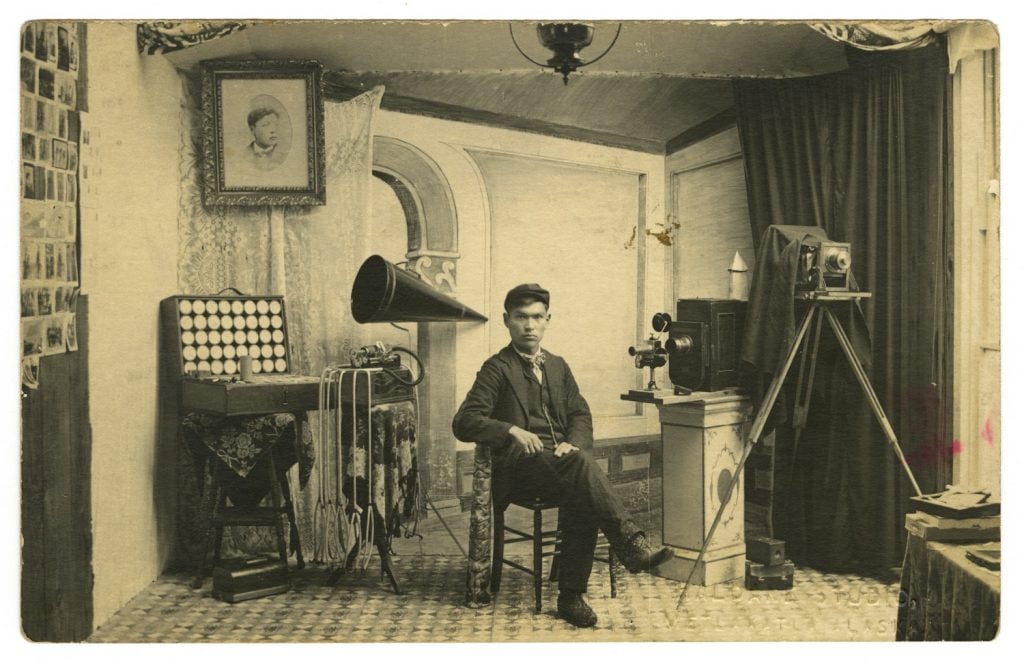
Benjamin A. Haldane, Self-portrait in Studio in Metlakatla (c. 1919–20). Courtesy of MIA.
Just the Facts: A foundational figure among Native and First Nation photographers, Benjamin Alfred Haldane made studio portraits of members of his Tsimshian community in Alaska at the turn of the 20th century. He often filled the frame with props that represented his subjects—an approach that imbued his work with a semiotic charge. He took the same tact for this expertly composed self-portrait from 1919 or 1920.
Expert Insights: “He uses all of these props to represent himself—to say, ‘This is what I do in the community,’” said Grey Eagle. “But on his arm, he has propped up a model totem pole, which is his clan crest—the wolf clan. The intentionality of choosing to connect his body to his heritage is so powerful to me. It’s such a rooted statement of who he is as a Tsimshian man.”
Faye HeavyShield, Clan (2020)
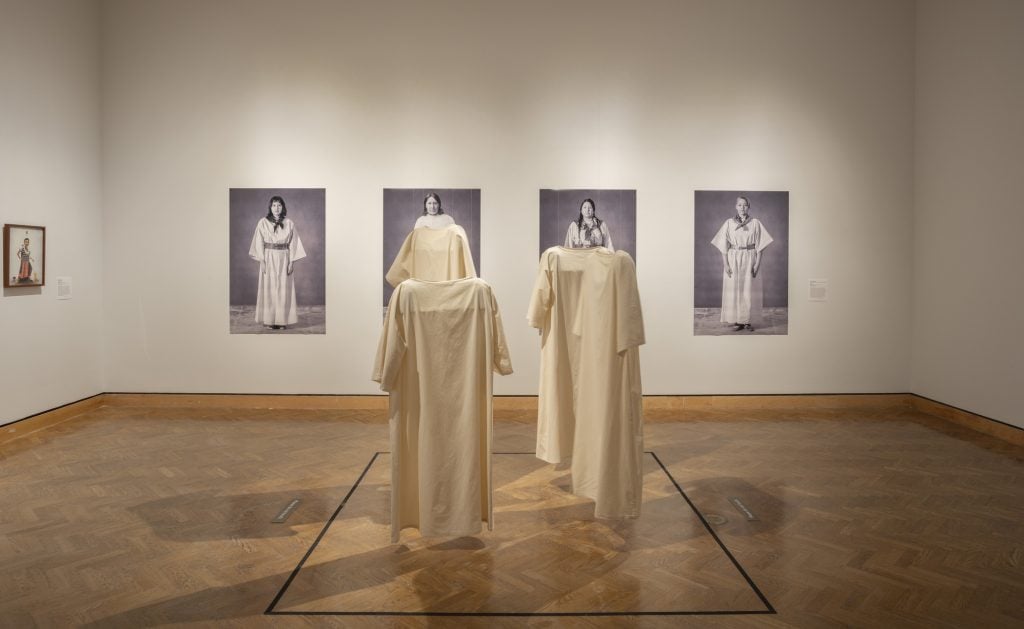
Installation view of Faye HeavyShield’s Clan (2020). Courtesy of MIA.
Just the Facts: One of the exhibition’s best-known artists, Faye HeavyShield makes sculptures, installations, and other artworks that are minimal in design, but broad in valence. At the core of what she does is the interrogation of the relationship—physical, spiritual—between land and body. HeavyShield was inspired to create Clan upon discovering a 1920s portrait of her grandmother. The work comprises a set of inkjet portraits, as well as a series of hanging canvas dresses.
Expert Insights: “She wanted to create this connection between her grandmother and her daughters and granddaughters that was beyond stories and memories,” Grey Eagle said, in reference to the portrait that inspired the artist. “I love Faye’s work because it’s sculptural, but it moves. There’s a lot of tactility within the show…It’s a way that I see Native photographers using [the medium] in this really incredible new way.”
Eve-Lauryn LaFountain, You Are on Native Land (2020)

Eve-Lauryn LaFountain, You Are on Native Land: Niibidoon (Weave) (2020). Courtesy of the artist and MIA.
Just the Facts: As part of a recent series, Eve-Lauryn LaFountain scratched the phrase “You Are on Native Land” across strips of found film that she had woven together. The artist then sent her creations to collaborators Cody Edison and Christine Wood, who in turn printed them as contact sheets. Now, these images are available for purchase as postcards, which are, according to the artists, meant to “act not as souvenirs of places from the sender, but rather as a reminder to the receiver that America was founded on the genocide and stolen lands of the Indigenous peoples of Turtle Island.” Proceeds from the project have been put toward supporting activists who were arrested in 2020 during a protest for the return of the Black Hills to the Lakota people. Three postcards hang in the “Always Leaders” section of the show.
Expert Insights: For LaFountain, You Are on Native Land extends beyond the postcards, Grey Eagle pointed out: “[LaFountain] would research the indigenous histories of each recipient’s address and write about the land that the postcards were going to.” The examples in the exhibition acknowledge the Dakota people, original caretakers of the land on which MIA sits, the curator added.
Jeremy Dennis, Door Prop (2018)

Jeremy Dennis, Door Prop (2018). Courtesy of the artist.
Just the Facts: In this moody photograph, a white woman cowers before an encroaching group of Native men, all dressed in stereotypic garb. The shot belongs to Dennis’s “Rise” series, which appropriates horror movie motifs as a way of reframing America’s colonization, displacement, and genocide of Native peoples.
Expert Insights: With Door Prop, Dennis reanimates “classic zombie movie aesthetics but replaces zombies with Native Americans,” Grey Eagle said. “He does that to frame white people’s fear of Native American people as this manifestation of [their own] wrongdoing. In his imagined uprising, Native people cannot be ignored. Their presence has to be acknowledged.”
Fittingly, Dennis’s artwork lives in “Always Present,” the exhibition’s last section. “I love that we leave on that,” Grey Eagle added. “When people talk about Native people, they always use past tense language. I hate that we have to say, ‘We’re still here,’ because we’ve always been here and we’re always going to be here.”
“In Our Hands: Native Photography, 1890 to Now” is on view through January 14, 2024 at the Minneapolis Institute of Art.
More Trending Stories:
News Icon Barbara Walters’s $8 Million Estate Hits the Block at Bonhams, With Her ‘Audacious’ Jewelry Taking Center Stage
There’s Much More to Caravaggio’s ‘The Cardsharps’ Than Vice. Here Are Three Facts That Offer a New Perspective on His Early Masterpiece
Here’s Your Guide to the Priciest and Most Sought-After Artworks for Sale During New York’s $2 Billion Fall Auction Season
Revealed: The Major Mystery Consignors of New York’s Multi-Billion-Dollar Fall Auction Season
A Secret Room in a 16th-Century Italian Chapel, Where Michelangelo Hid—and Drew—for Months, Opens to the Public
Christie’s Pulled Two Works by a Prominent Middle Eastern Artist From Sale After a Complaint
A Nautical Chart Sold at Auction for $239,000 Is Revealed as the 4th Oldest of Its Kind and Is Now Tagged at $7.5 Million
